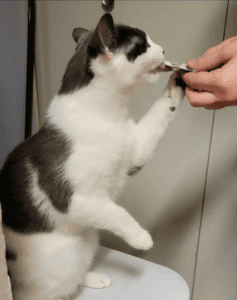In short, yes. Studies have shown that an all-wet food-based diet not only has higher animal-based protein but contains the highest amount of water that your kitty requires. Unfortunately, it may seem like cats are drinking enough water, but many come into the vet dehydrated. Cats are very inefficient water drinkers. In the wild, cats gain most of their hydration through their prey. This is due to many wild cats (including the ancestor to house cats) being desert dwelling animals. Cats tend not to drink water until they are very thirsty, and then usually not very much. Most dry food only contains 6-8% water content. Wet food contains 70-80% water content.
While dry food is cheaper to buy in bulk, the health issues that can arise from an all-dry food diet can end up costing you thousands in medical bills. Wet food does not have to mean buying the most expensive can on the shelf, the most important aspect of cat food is looking at the ingredient list. Good cat food should have meat as its first few ingredients. With wet food, even cheaper brands tend to follow this, while dry food tends to have plant by-products as the first ingredients. As obligate carnivores (meaning kitties can only get all their nutrition through meat) plant proteins come with lots of carbs that can make your cat have upset stomach and weight problems. Overall, it will be cheaper in preventative care to switch to a wet food diet.
UTI’s and GI tract issues are common among felines. If you have ever had to deal with a urinary blockage or bladder stones in your feline, you know it is neither fun nor cheap. Wet food diets are proven to lower the chances of a urinary tract infection by adding hydration to your felines diet and cutting the carbs. When your cat is more hydrated the water concentration in your cat’s urine increases which helps dilute toxins and harmful chemicals from your cat’s pee, this lightens the work load their kidneys need to do and lowers the chance of stones and blockages.
A common myth that dry food helps keep teeth clean has been proven to be false. Cats are predators which prefer to eat their food in large chunks with minimal chewing. This means when they consume kibble, they are at best chew each piece in half, providing minimal benefit of removing tarter and building jaw strength. Even dry food brands declaring they will help your kitty’s dental health end up only benefiting a few teeth in the mouth, overall rendering the purpose of the kibble to be minimal. The best way to care for your cat’s teeth is getting them comfortable with having regular checkups on their teeth!
Now that we have covered the basics around what to feed your cat let us get into the fun stuff, treats! We all adore them, and they are the perfect way to train your kitty or just show them some extra lovin’. But what treats should we use to indulge kitty?
First, cats are carnivores. This means their digestive track does not have the enzymes present to digest fruits and vegetables, in fact some vegetables (onions for example) are extremely toxic for your kitty. However, some plants do have some benefits. Catnip is a fun treat that many older cats love to eat and roll around in. Pumpkin has also been shown to be a helpful source of fiber if your kitty is feeling constipated. Just make sure to stay away from pumpkin pie, those spices are not as good for them even if we think it is tasty.
Meat based treats (Greenies, churu, plain freeze dried/boiled chicken breast) are all acceptable treats, if they are given sparingly and not as the main course. Many pet stores carry diverse types of treats; your furry co-pilot may love goopy churu, or prefer to look into the eyes of dried minnows. Take the time to experiment and you will find that jackpot treat that improves your relationship and gets your cat motivated for a meaty snack.

Your cat’s diet can help them live longer, happier, and healthier lives. Ask your vet to come up with a diet or feeding plan specific to your cat’s needs!


